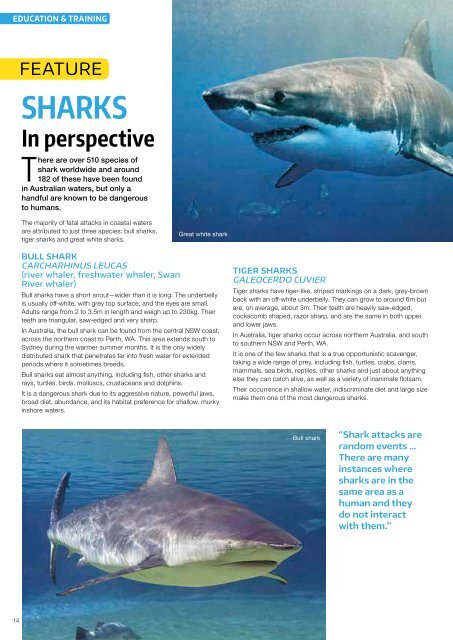isla
6YImNOtrh
6YImNOtrh
Create successful ePaper yourself
Turn your PDF publications into a flip-book with our unique Google optimized e-Paper software.
education & training<br />
education & training<br />
Feature<br />
Tiger shark<br />
Sharks<br />
In perspective<br />
There are over 510 species of<br />
shark worldwide and around<br />
182 of these have been found<br />
in Australian waters, but only a<br />
handful are known to be dangerous<br />
to humans.<br />
The majority of fatal attacks in coastal waters<br />
are attributed to just three species: bull sharks,<br />
tiger sharks and great white sharks.<br />
Bull shark<br />
Carcharhinus leucas<br />
(river whaler, freshwater whaler, Swan<br />
River whaler)<br />
Great white shark<br />
Bull sharks have a short snout—wider than it is long. The underbelly<br />
is usually off-white, with grey top surface, and the eyes are small.<br />
Adults range from 2 to 3.5m in length and weigh up to 230kg. Their<br />
teeth are triangular, saw-edged and very sharp.<br />
In Australia, the bull shark can be found from the central NSW coast,<br />
across the northern coast to Perth, WA. This area extends south to<br />
Sydney during the warmer summer months. It is the only widely<br />
distributed shark that penetrates far into fresh water for extended<br />
periods where it sometimes breeds.<br />
Bull sharks eat almost anything, including fish, other sharks and<br />
rays, turtles, birds, molluscs, crustaceans and dolphins.<br />
It is a dangerous shark due to its aggressive nature, powerful jaws,<br />
broad diet, abundance, and its habitat preference for shallow, murky<br />
inshore waters.<br />
Tiger sharks<br />
Galeocerdo cuvier<br />
Tiger sharks have tiger-like, striped markings on a dark, grey-brown<br />
back with an off-white underbelly. They can grow to around 6m but<br />
are, on average, about 3m. Their teeth are heavily saw-edged,<br />
cockscomb shaped, razor sharp, and are the same in both upper<br />
and lower jaws.<br />
In Australia, tiger sharks occur across northern Australia, and south<br />
to southern NSW and Perth, WA.<br />
It is one of the few sharks that is a true opportunistic scavenger,<br />
taking a wide range of prey, including fish, turtles, crabs, clams,<br />
mammals, sea birds, reptiles, other sharks and just about anything<br />
else they can catch alive, as well as a variety of inanimate flotsam.<br />
Their occurrence in shallow water, indiscriminate diet and large size<br />
make them one of the most dangerous sharks.<br />
Great white shark<br />
Carcharodon carcharias<br />
(white pointer, white shark, white death)<br />
The underbelly of the great white shark is the only area that is actually<br />
white, the top surface of the shark is grey, blue/grey or bronze.<br />
The biggest recorded great white was 7m long and weighed<br />
3,200kg. Their teeth are large, saw-edged and triangular.<br />
In Australia, great white sharks have been recorded from central<br />
Queensland, around the southern coast to North West Cape,<br />
WA—however, they are more common in the south.<br />
Young great whites (under about 3.5m) eat mainly a variety of fish,<br />
rays and other sharks. Larger adults eat larger prey, including marine<br />
mammals such as sea lions and seals, small-toothed whales and<br />
otters. They also eat dead animals floating in the water.<br />
Great whites are a protected species in many Australian states, and<br />
also in several other countries.<br />
Shark Attacks in Perspective<br />
Compared to injuries and fatalities from other forms of waterrelated<br />
activities, the number of shark attacks in Australia is<br />
very low. In the last 50 years there have been 47 unprovoked<br />
shark attack fatalities averaging just under one per year (0.94).<br />
There is an element of risk in any activity, and the risk of a<br />
person being injured or killed by a shark must be viewed<br />
in perspective.<br />
“Shark attacks are random events—no shark knows when a human<br />
will enter the water so they can time an attack! There are many<br />
instances where sharks are in the same area as a human and they<br />
do not interact with them. Although random shark attacks can<br />
cluster (occurring in a particular area or over a time period) and may<br />
seem to many as an increasingly common event over time it is<br />
shown that the number of incidents at a location or time of the year<br />
vary from year to year and should be analysed over decades for<br />
trends.” John West, Australian Shark Attack File.<br />
Sources: NSW Department of Primary Industries; Australian Shark<br />
Attack File (ASAF), Taronga Zoo, Sydney.<br />
Bull shark<br />
“Shark attacks are<br />
random events …<br />
There are many<br />
instances where<br />
sharks are in the<br />
same area as a<br />
human and they<br />
do not interact<br />
with them.”<br />
Unprovoked Cases (last 100 years only) as of December 2015<br />
State # Cases Fatal Injured Uninjured Last Unprovoked<br />
fatality<br />
NSW 212 49 111 52 Ballina 2015<br />
QLD 160 56 87 17 Palm Island 2011<br />
WA 79 14 53 12 Gracetown 2013<br />
SA 42 13 22 7 Glenelg 2005<br />
VIC 32 3 19 10 Mornington Peninsula 1987<br />
TAS 9 1 5 3 Maria Island 2015<br />
NT 8 1 6 1 Cobourg Peninsula 1934<br />
Note: An ‘unprovoked’ encounter between a human and a shark is defined as an incident where a shark is in its natural habitat<br />
and has made a determined attempt to bite a human where that person is not engaged in provocative activities. Incidents classified<br />
as ‘provoked’ are not included in these statistics.<br />
Source: Australian Shark Attack File, Taronga Zoo, Sydney<br />
14<br />
Australian Lifeguard Magazine 15


